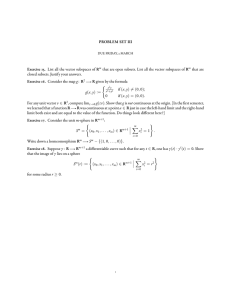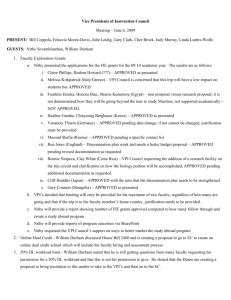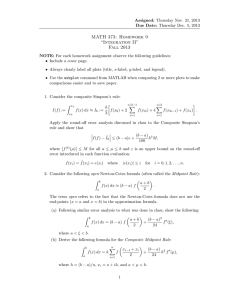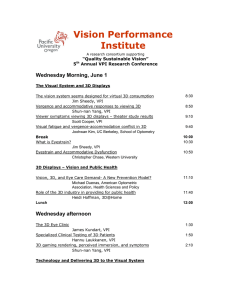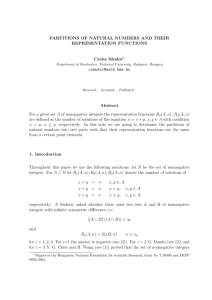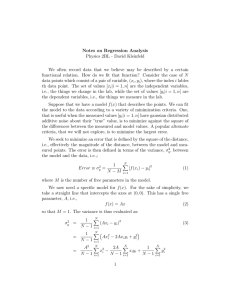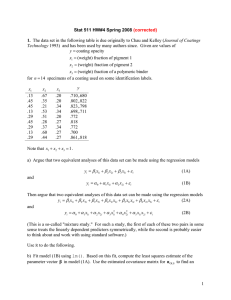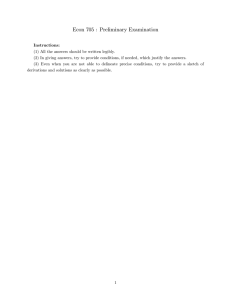Math 405: Numerical Methods for Differential Equations 2015 W1
advertisement
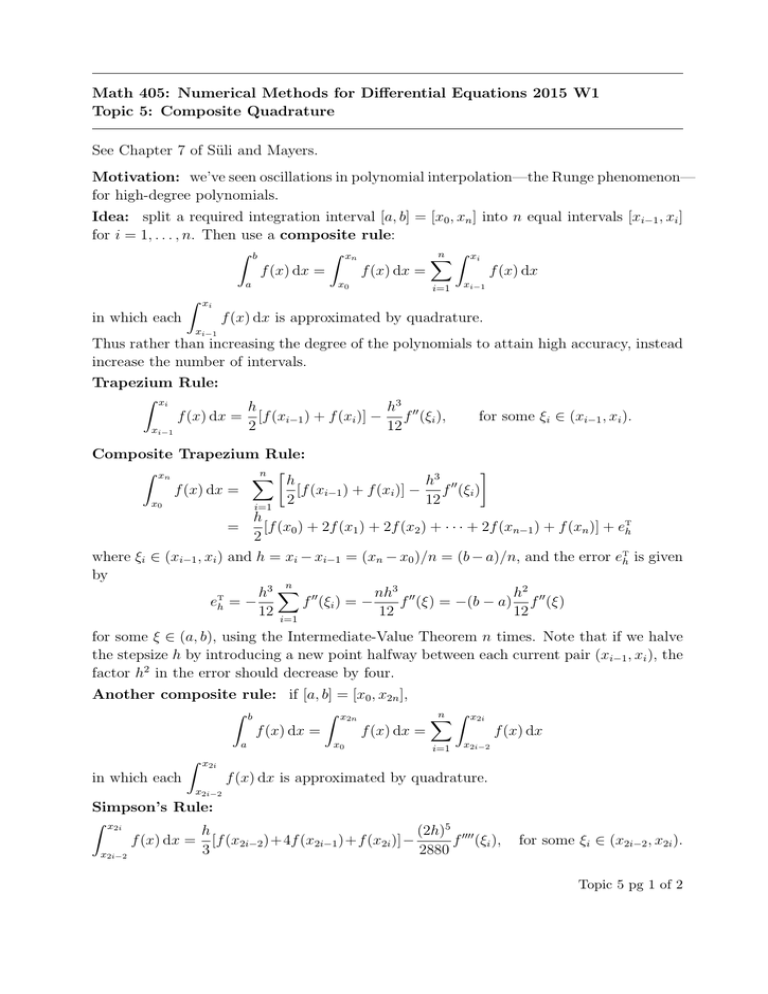
Math 405: Numerical Methods for Differential Equations 2015 W1 Topic 5: Composite Quadrature See Chapter 7 of Süli and Mayers. Motivation: we’ve seen oscillations in polynomial interpolation—the Runge phenomenon— for high-degree polynomials. Idea: split a required integration interval [a, b] = [x0 , xn ] into n equal intervals [xi−1 , xi ] for i = 1, . . . , n. Then use a composite rule: Z xn Z b n Z xi X f (x) dx = f (x) dx f (x) dx = a Z x0 i=1 xi−1 xi in which each f (x) dx is approximated by quadrature. xi−1 Thus rather than increasing the degree of the polynomials to attain high accuracy, instead increase the number of intervals. Trapezium Rule: Z xi h h3 00 f (x) dx = [f (xi−1 ) + f (xi )] − f (ξi ), 2 12 xi−1 for some ξi ∈ (xi−1 , xi ). Composite Trapezium Rule: Z xn n X h h3 00 f (x) dx = [f (xi−1 ) + f (xi )] − f (ξi ) 2 12 x0 i=1 h = [f (x0 ) + 2f (x1 ) + 2f (x2 ) + · · · + 2f (xn−1 ) + f (xn )] + eTh 2 where ξi ∈ (xi−1 , xi ) and h = xi − xi−1 = (xn − x0 )/n = (b − a)/n, and the error eTh is given by n h3 X 00 nh3 00 h2 T eh = − f (ξi ) = − f (ξ) = −(b − a) f 00 (ξ) 12 i=1 12 12 for some ξ ∈ (a, b), using the Intermediate-Value Theorem n times. Note that if we halve the stepsize h by introducing a new point halfway between each current pair (xi−1 , xi ), the factor h2 in the error should decrease by four. Another composite rule: if [a, b] = [x0 , x2n ], Z b Z x2n n Z X f (x) dx = f (x) dx = a Z x0 i=1 x2i f (x) dx x2i−2 x2i in which each f (x) dx is approximated by quadrature. x2i−2 Simpson’s Rule: Z x2i (2h)5 0000 h f (ξi ), f (x) dx = [f (x2i−2 )+4f (x2i−1 )+f (x2i )]− 3 2880 x2i−2 for some ξi ∈ (x2i−2 , x2i ). Topic 5 pg 1 of 2 Composite Simpson’s Rule: Z x2n n X h (2h)5 0000 f (x) dx = [f (x2i−2 ) + 4f (x2i−1 ) + f (x2i )] − f (ξi ) 3 2880 x0 i=1 h [f (x0 ) + 4f (x1 ) + 2f (x2 ) + 4f (x3 ) + 2f (x4 ) + · · · = 3 + 2f (x2n−2 ) + 4f (x2n−1 ) + f (x2n )] + eSh where ξi ∈ (x2i−2 , x2i ) and h = xi − xi−1 = (x2n − x0 )/2n = (b − a)/2n, and the error eSh is given by n (2h)5 X 0000 n(2h)5 0000 h4 0000 S eh = − f (ξi ) = − f (ξ) = −(b − a) f (ξ) 2880 i=1 2880 180 for some ξ ∈ (a, b), using the Intermediate-Value Theorem n times. Note that if we halve the stepsize h by introducing a new point half way between each current pair (xi−1 , xi ), the factor h4 in the error should decrease by sixteen (assuming f is smooth enough). Adaptive (or automatic) procedure: if Sh is the value given by Simpson’s rule with a stepsize h, then 15 Sh − S 1 h ≈ − eSh . 2 16 Z b This suggests that if we wish to compute f (x) dx with an absolute error ε, we should a compute the sequence Sh , S 1 h , S 1 h , . . . and stop when the difference, in absolute value, 2 4 between two consecutive values is smaller than 16 ε. That will ensure that (approximately) 15 S |eh | ≤ ε. Often spatially-varying adaptivity is used in practice: refine only is regions where a local estimate is large. Comments: Sometimes much better accuracy may be obtained: for example, as might happen when computing Fourier coefficients, if f is periodic with period b − a so that f (a + x) = f (b + x) for all x. Topic 5 pg 2 of 2

